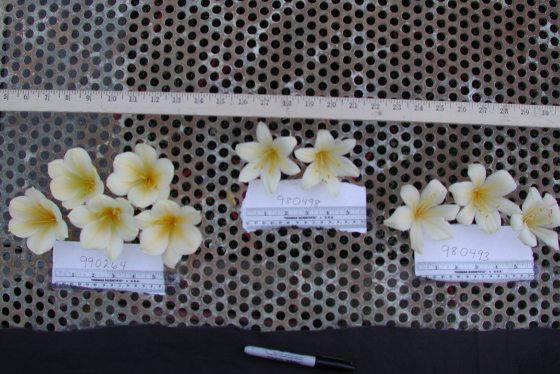When Dr. Robert Armstrong first began breeding clivia at Longwood in 1976, available plants were orange-flowered varieties, while yellow-flowered forms were quite rare and were generally weak plants with small flowers and poor habits. Thus the original goal of the breeding program was to produce a superior yellow-flowering plant, which was a long process due to the slow growth of clivia from seed.

The breeding project began by crossing a clivia with small yellow flowers and poor plant habit with an orange-flowered plant that had exceptionally large flowers. The resulting F1 hybrids were all orange-flowered, suggesting the yellow flower phenotype was recessive. Therefore, we intercrossed and backcrossed seedlings of the F1 generation with the yellow-flowered parent. Both of these crosses resulted in plants with large yellow flowers, but they were floppy and not significantly better than the original yellow-flowered parent.
Then Longwood received a yellow-flowered clivia that had an upright formal habit with flowers held above the foliage. We have since named this cultivar ‘Sir John Thouron’ after the man who donated the plants. We quickly made crosses between the best yellow seedlings from the F2 and backcross populations mentioned above and Clivia ‘Sir John Thouron’. Many of the progeny had outstanding flower size, number, and form, as well as excellent plant habit.

Three unusual seedlings, one orange and two yellow-flowered, emerged from the breeding program. These seedlings had flower mutations known as “keeled” petals, which produced flowers with a semi-double or ruffled appearance. The seedlings from crosses of plants with keeled petals varied from individuals with no keeling at all to ones with more pronounced keeling than the parents. There were also flowers where the “keel” actually separated from the petal to form an extra set of petals. Thus, the appearance of keeled petals led to a new selection goal.
Longwood Releases
Thirty-five years in the making, Clivia miniata ‘Longwood Debutante’ made its debut at the 2011 North American Clivia Society’s International Symposium and Show. This plant’s slightly fragrant, buttery yellow flowers have overlapping petals that produce a beautiful floral display.
The second release from the program in 2012 was also a yellow-flowered plant, Clivia miniata ‘Longwood Fireworks’, so named because its blooms are presented on a round umbel with stamens that appear to shoot out of the flowers like fireworks.
We released Clivia miniata ‘Longwood Sunrise’ in 2014, with beautiful orange keeled petals. As noted above, the keel changes the shape and appearance of the flowers and gives them more depth and texture. Keeling clivia flowers are rare and occurred randomly in Longwood’s seedlings, but our breeding efforts resulted in beautiful, consistently keeling flowers. Future clivia releases will include unique yellow and orange keeling varieties.
In 2016 Longwood Gardens announced the release of Clivia miniata ‘Longwood Chimes’. The flowers are a complex blend of bronze and burnt oranges with dark red overtones and a green throat. The red flush of the flowers, framed by leaves of dark olive green, deepens to dark red as the flowers age. Now that orange and yellow clivia flowers are common, collectors crave new and exciting colors like the red flowers of ‘Longwood Chimes’.
Longwood Gardens released its fifth clivia cultivar, Clivia miniata ‘Longwood Sunset’, in 2017. Selected and named for its pastel-colored flowers, this clivia was a color breakthrough in our 40-year-long breeding program. The soft, salmon tones of the tepals contrast with a striking butter yellow and white throat. Furthermore the large, reflexed tepals are framed by a fine, red-orange picotee edge, a unique feature for clivia.
The Longwood breeding program has also produced an incredible green-flowered seedling with large flowers. Most greens available in the trade today have come from the same breeding lines that contain the green-flowered Clivia ‘Hirao’. Longwood’s green is from a new genetic line, and is a much larger plant than ‘Hirao’. We hope that within the next decade, there will be enough of the green-flowered Longwood plant to allow its naming and release.
From Our Blog - Clivia
-
Longwood Releases Clivia miniata ‘Longwood Sunset’

Blog
Longwood Releases Clivia miniata ‘Longwood Sunset’
With soft, pastel-colored flowers, Clivia miniata ‘Longwood Sunset’ is a color breakthrough for our 40-year-old clivia breeding program.
-
Introducing Clivia miniata ‘Longwood Chimes’

Blog
Introducing Clivia miniata ‘Longwood Chimes’
We are pleased to announce the release of Clivia miniata ‘Longwood Chimes’. This is the fourth named clivia introduction from our breeding program, which was started by Dr. Robert Armstrong in 1976.
-
Longwood Launches New ‘Fireworks’

Blog
Longwood Launches New ‘Fireworks’
Excited to introduce to you a completely new type of Fireworks at Longwood Gardens—Clivia miniata ‘Longwood Fireworks’!
-
'Longwood Debutante' Ready for Debut

Blog
'Longwood Debutante' Ready for Debut
After 35 years of clivia breeding, Longwood Gardens released its first named clivia when the North American Clivia Society held its International Symposium and Show at Longwood Gardens in 2011.